Grace Robert. Advanced Blowout and Well Control
Подождите немного. Документ загружается.


366
Advanced
Blowout
and
Well
Control
Reference
1.
Booth,
Jake,
"Use
of
Shallow Seismic
Data
in Relief Well
Planning," World Oil,
May
1990, page
39.
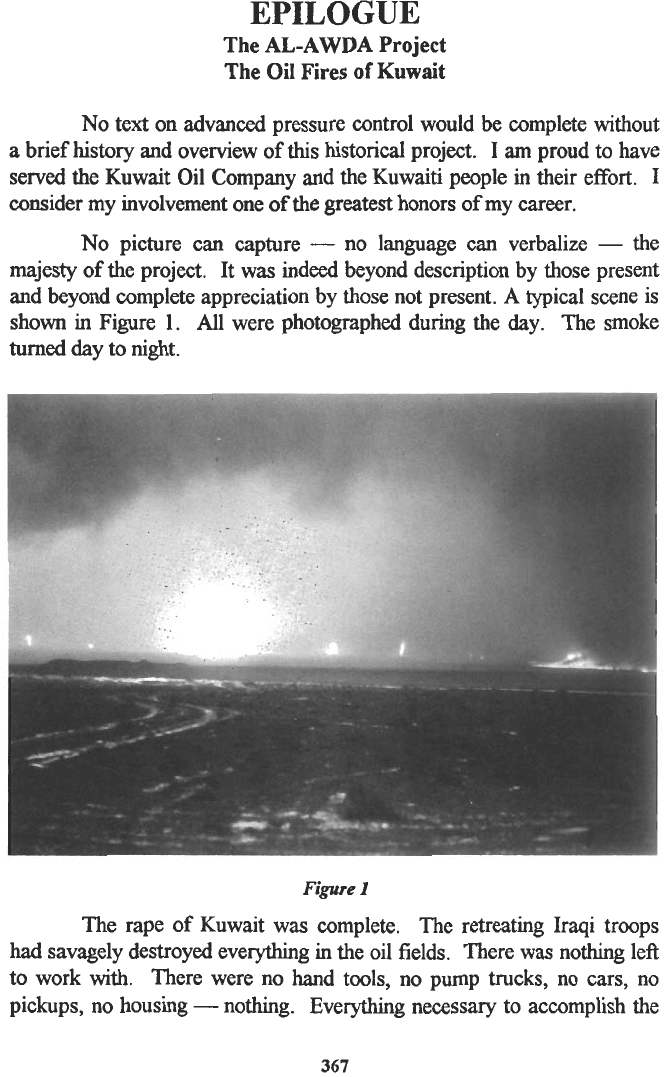
EPILOGUE
The
AL-AWDA
Project
The
Oil
Fires
of
Kuwait
No
text on advanced pressure control would be complete without
a
brief
history
and overview
of
this
historical project. I
am
proud to have
served the Kuwait Oil Company and the Kuwaiti people in their effort. I
consider my involvement one
of
the
greatest
honors of my career.
No
picture can capture
-
no language
can
verbalize
-
the
majesty of the project. It was indeed beyond description by those present
and beyond complete appreciation by those not present.
A
typical scene is
shown
in
Figure
1.
All were photographed during the
day.
The smoke
turned day to night.
Figure
I
The rape
of
Kuwait was complete. The retreating Iraqi troops
had
savagely destroyed everythmg in the oil fields. There was nothing left
to
work with.
There were
no
hand tools, no pump trucks, no cars, no
pickups, no housing
-
nothing. Everythmg necessary to accomplish the
367
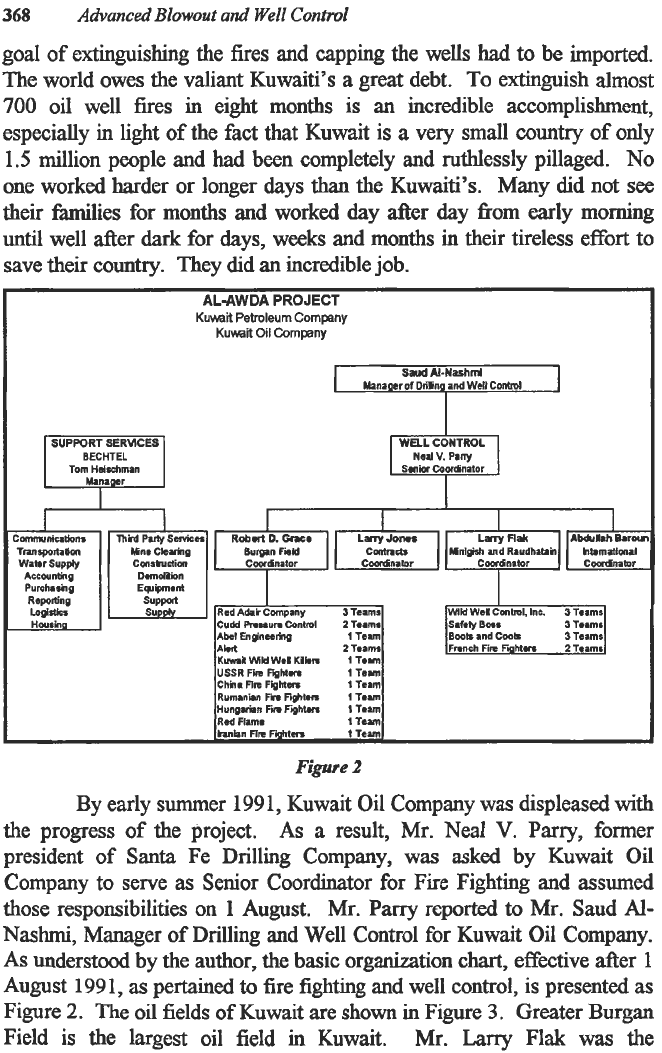
368
goal of extinguishing the fies and capping the wells
had
to
be
imported.
The world owes the valiant Kuwaiti’s a great debt.
To
extinguish
almost
700
oil well fires
in
eight months is
an
incredible accomplishment,
especially
in
light of the fact that Kuwait is
a
very small counfry
of
only
1.5 million people and
had
been completely and ruthlessly pillaged. No
one worked harder or
longer
days
than
the
Kuwaiti’s.
Many did
not
see
their families for
months
and
worked
day after day fiom early
morning
until well after dark
for
days, weeks and
months
in
their tireless effort to
save their country.
They
did
an incredible job.
Ad~anced
Blowout
and
Well
Control
AL-AWDA
PROJECT
Kumit
Petroleum
Company
Kuwait
Oil
Company
SUPPORT
SERMCES
BECHTEL
Tom
Hdrshman
Neal
V.
Pamy
Figure
2
By early summer
199
1, Kuwait Oil Company was displeased with
the progress of the project.
As
a result,
Mr.
Neal
V.
Parry, former
president
of
Santa
Fe
Drilling
Company,
was
asked
by Kuwait Oil
Company
to
serve
as
Senior Coordinator for Fire Fighting and
assumed
those responsibilities on
1
August.
Mr.
Parry
reported
to
Mr. Saud
Al-
Nashmi,
Manager
of
Drilling
and
Well Control for Kuwait Oil Company.
As
understood by the author, the basic organization
chart,
effective after
1
August 199
1,
as
pertained
to
fire fighting and well control,
is
presented as
Figure
2.
The
oil
fields
of
Kuwait are shown in Figure
3.
Greater Burgan
Field is the largest oil field
in
Kuwait. Mr.
Larry
Flak was the
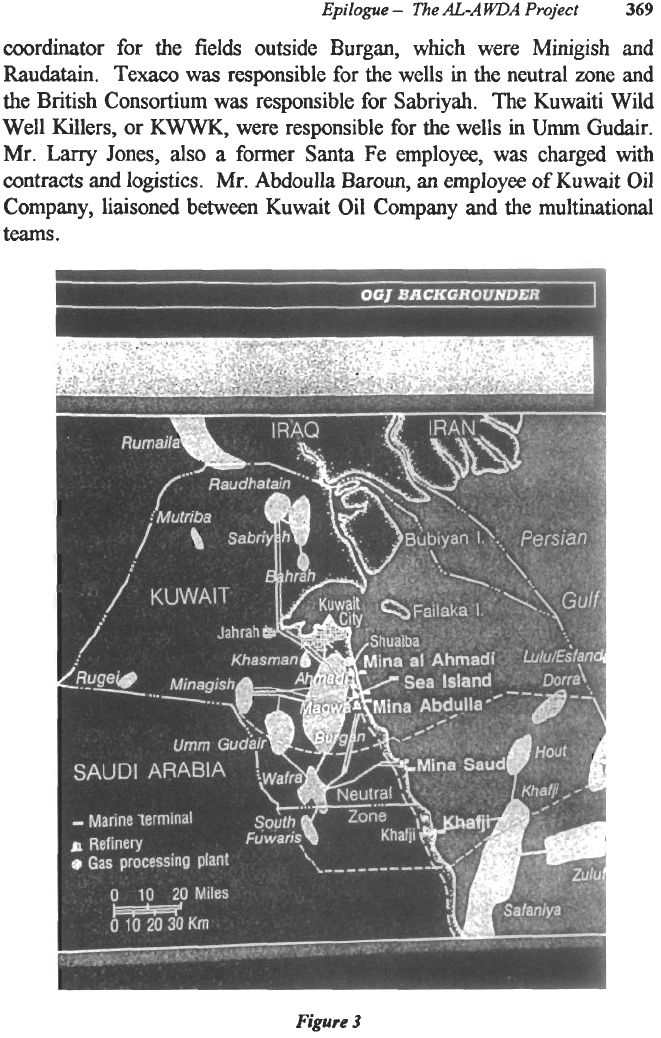
Epilogue
-
The
AL-AWWA
Project
369
coordinator
for
the fields outside Burgan, which were Minigish and
Raudatain. Texaco was responsible for the wells
in
the neutral zone and
the
British Consortium was responsible for Sabriyah. The Kuwaiti Wild
Well Killers, or KWWK, were responsible for the wells
in
Umm
Gudair.
Mr.
Larry
Jones,
also
a
former Santa
Fe
employee, was charged
with
contracts and logistics.
Mr.
Abdoulla Baroun, an employee
of
Kuwait Oil
Company, liaisoned between Kuwait Oil Company and the multinational
teams.
Figure
3
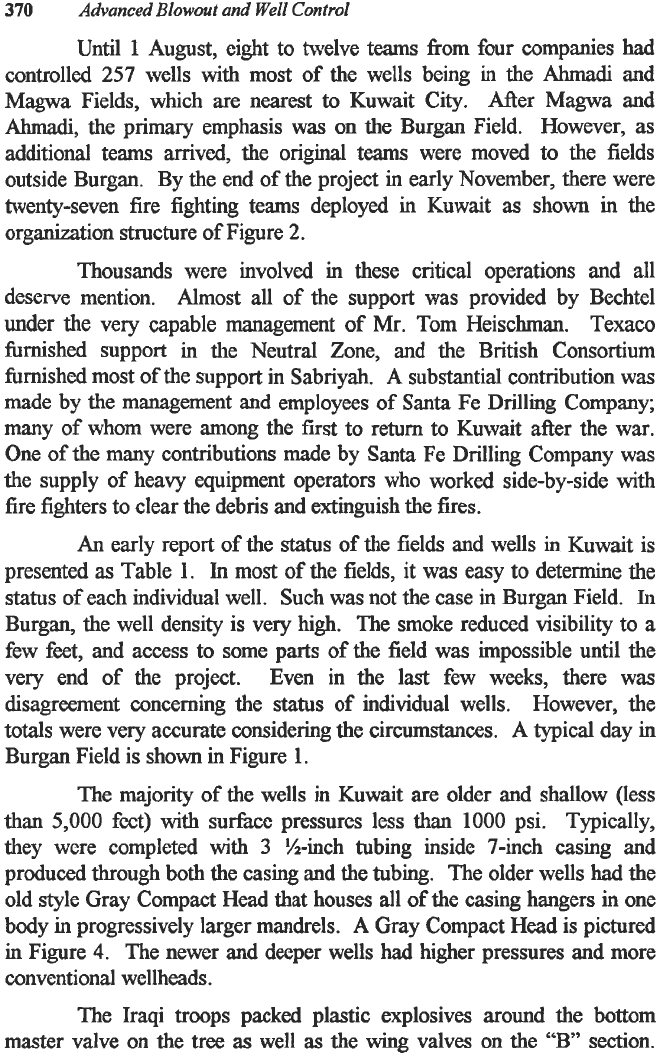
370
Advanced
Blowout
and Well
Control
Until
1
August, cight to twelve teams fiom four companies
had
controlled
257
wells with most of the wells being in the
Ahmadi
and
Magwa Fields, which are nearest
to
Kuwait City. Mer Magwa and
Ahmadi,
the primary emphasis was on the Burgan Field. However, as
additional teams arrived, the original teams were moved to the fields
outside Burgan. By the end of the project in early November, there were
twenty-seven fire fighting teams deployed in Kuwait
as
shown
in the
organization structure of Figure
2.
Thousands were involved in these critical operations and all
deserve mention. Almost all of the support was provided by Bechtel
under the very capable management of Mr. Tom Heischman. Texaco
furnished support in the Neutral Zone, and the British Consortium
furnished most
of
the support in Sabriyah. A substantial contribution was
made by the management and employees
of
Santa Fe Drilling Company;
many of whom were among the first to return to Kuwait after the war.
One of the many contributions made by Santa Fe Drilling Company was
the supply of heavy equipment operators who worked side-by-side with
fire fighters
to
clear the debris and extinguish the fires.
An
early report of the status of the fields and wells in Kuwait is
presented
as
Table
1.
In most of the fields, it was easy to determine the
status
of
each individual well. Such was not the case in Burgan Field. In
Burgan, the well density is very high. The smoke reduced visibility to a
few feet, and access to some parts of the field was impossible until the
very end of the project. Even in the
last
few weeks, there was
disagreement concerning the status of individual wells. However, the
totals
were very accurate considering the circumstances. A typical day in
Burgan Field is shown in Figure 1.
The majority of the wells in Kuwait are older and shallow (less
than
5,000 fat) with surfacc pressures less than 1000 psi. Typically,
they wcre completed
with
3
‘/-inch tubing inside 7-inch casing and
produced through both the casing and the tubing. The older wells
had
the
old style Gray Compact Head that houses all of the casing hangers in one
body in progressively larger mandrels.
A
Gray Compact Head
is
pictured
in Figure
4.
The newer and deeper wells
had
higher pressures and more
conventional wellheads.
The Iraqi troops packed plastic explosives around the bottom
master valve on the tree
as
well
as
the
wing
valves on the
“B
section.
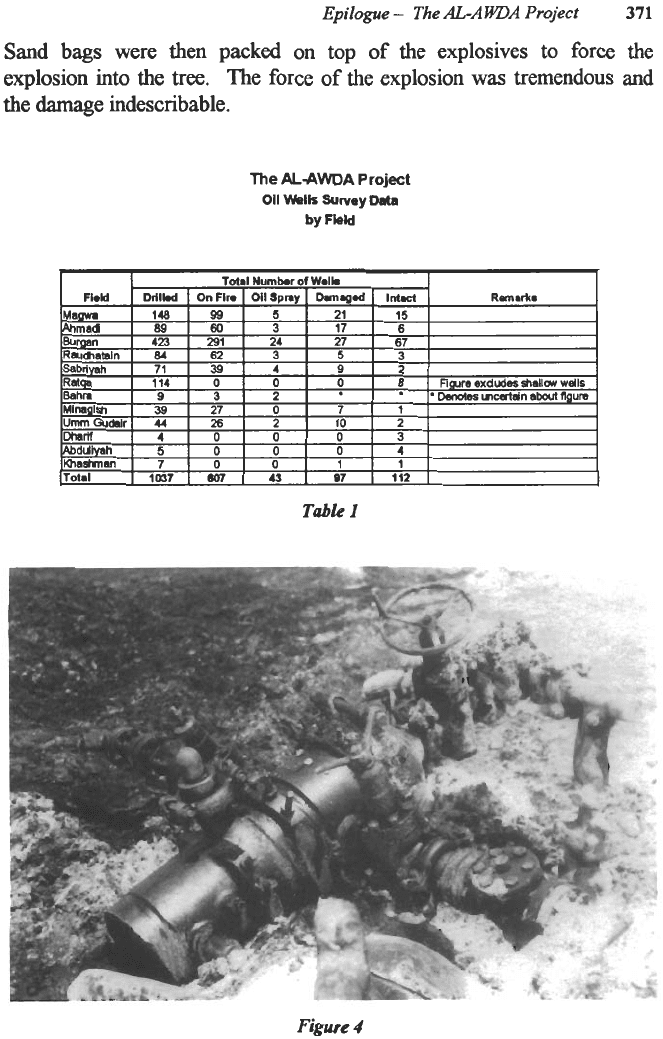
Epilogue
-
The
ALAWLlA
Project
371
Sand
bags
were then packed on top
of
the explosives
to
force
the
explosion
into
the
tree.
The
force of
the explosion was tremendous and
the damage indescribable.
The
ALAWDA
Project
Oil
Walk
Survey
Data
by
Flew
Table
1
Figure
4
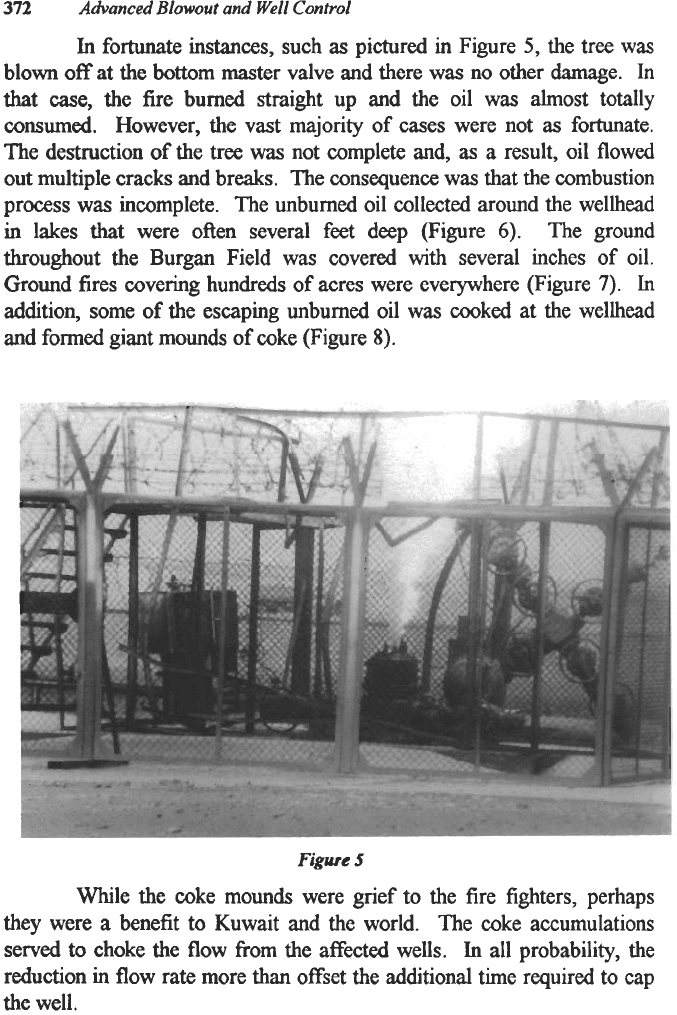
372
Advanced
Blowout
and
Well
Contml
In
fortunate instances, such
as
pictured in Figure
5,
the tree was
blown
off
at
the bottom
master
valve and there was no other damage.
In
that
case, the fire burned straight up and the oil
was
almost totally
consumed. However, the vast
majority
of
cases were not
as
fortunate.
The destruction
of
the
tree
was
not complete and,
as
a
result, oil flowed
out multiple cracks and breaks. The consequence
was
that
the
combustion
process was incomplete. The unburned oil collected around the wellhead
in
lakes
that
were often several
feet
deep
(Figure
6).
The ground
throughout the Burgan Field was covered with several inches
of
oil.
Ground fires covering hundreds
of
acres were everywhere (Figure
7).
In
addition, some of the escaping unburned oil
was
cooked
at the wellhead
and
formed
giant mounds
of
coke (Figure
8).
Figure
5
While the coke mounds were grief to the fire fighters, perhaps
they were
a
benefit to Kuwait and the world. The coke accumulations
served
to
choke the flow from the
affeded
wells.
In
all probability, the
reduction in flow rate more
than
offset the additional time required to cap
the well.
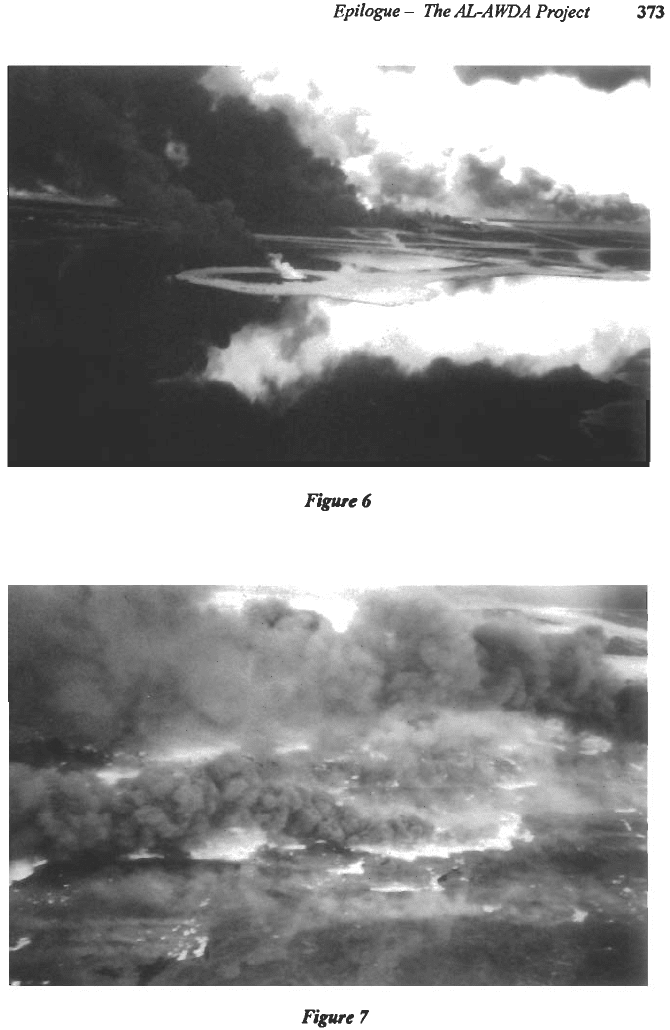
Epilogue
-
fie
ALAWDA
Pmject
373
v
-
__/_
figure
6
Figure
7
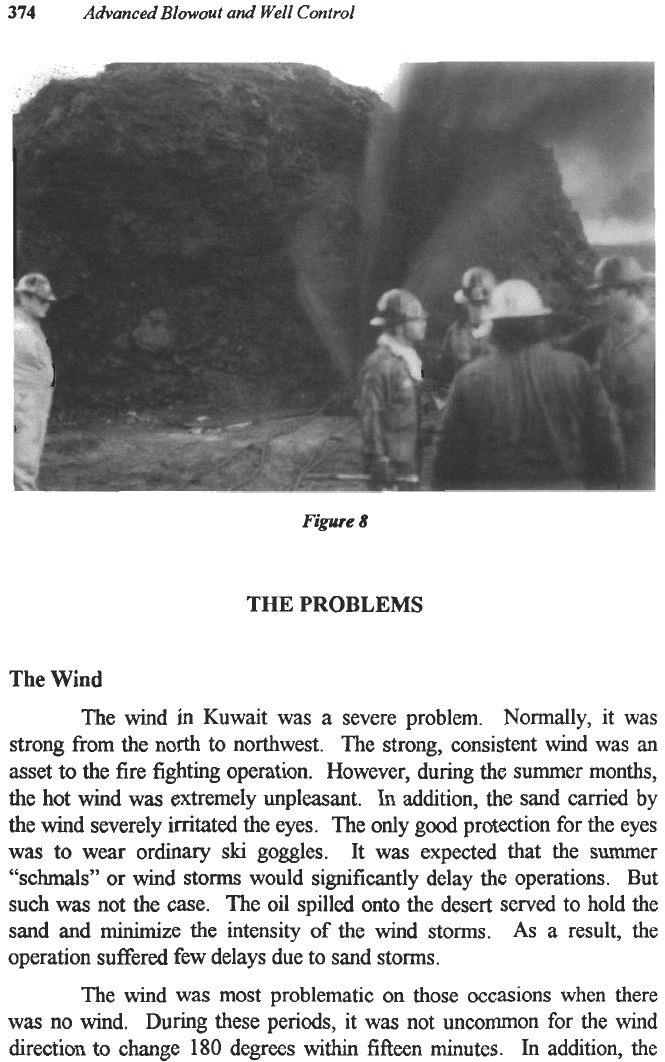
374
Advanced Blowout and Well Control
Figure 8
THE
PROBLEMS
The
Wind
The wind in Kuwait was a severe problem. Normally, it was
strong from the north to northwest. The strong, consistent wind was
an
asset
to the fire fighting operation. However, during the summer months,
the hot wind was extremely unpleasant.
In
addition, the sand carried by
the wind severely irritated the eyes. The only good protection for the eyes
was
to
wear ordinaq
ski
goggles.
It was expected
that
the summer
“schmals” or wind
storms
would significantly delay the operations.
But
such was not the case. The oil spilled onto the desert served to hold the
sand and minimize the intensity
of
the wind storms.
As
a result, the
operation suffered few delays due to sand storms.
The wind was most problematic on those occasions when there
was no wind. During these periods, it was not uncommon for the wind
direction to change
180
degrees
within
fifteen minutes.
In addition, the
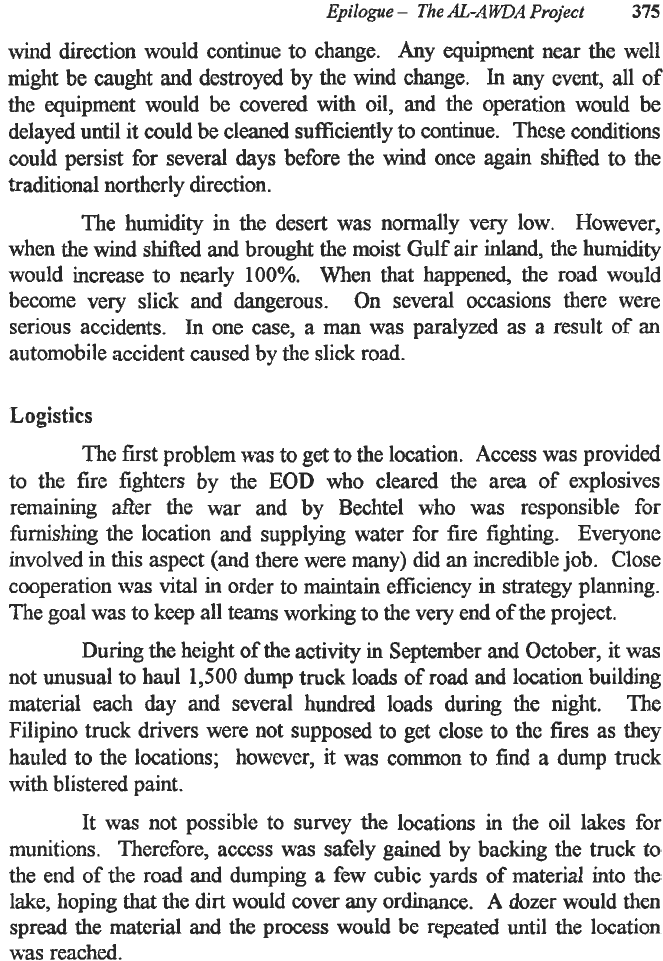
Epilogue
-
The
AL-A
MIA
Project
375
wind direction would continue to change. Any equipment near the well
might be caught and destroyed by the wind change.
In
any
event, all of
the equipment would be covered with oil, and the operation would be
delayed until it could be cleaned sufficiently
to
continue. These conditions
could persist for several days before the wind once again shifted to the
traditional northerly direction.
The humidity in the desert was normally very low. However,
when the wind shifted and brought the moist
Gulf
air inland, the humidity
would increase to nearly
100%.
When that happened, the road would
become very slick and dangerous. On several occasions there were
serious accidents. In one case, a man was paralyzed
as
a result of an
automobile accident caused by the slick road.
Logistics
The first problem was to get to the location. Access was provided
to the fire fighters by the
EOD
who cleared the area of explosives
remaining after the war and by Bechtel who was responsible for
furnishing the location and supplying water for fire fighting. Everyone
involved in this aspect (and there were many) did an incredible job. Close
cooperation
was
vital
in order to maintain efficiency in strategy planning.
The goal was to keep all teams working to the very end of the project.
During the height of the activity in September and October, it was
not unusual
to
haul
1,500
dump truck loads of road and location building
material each
day
and several hundred loads during the night. The
Filipino truck drivers were not supposed to get close
to
the fires as they
hauled to the locations; howcvcr, it
was
common to find
a
dump truck
with blistered paint.
It was not possible to survey the locations in the oil lakes for
munitions. Therefore, access was safely gained by backing the truck to
the end
of
the road and dumping
a
few cubic yards
of
material into the
lake, hoping that the dirt would cover any ordinance.
A
dozer would then
spread the material and the process would
be
repeated until the location
was reached.
